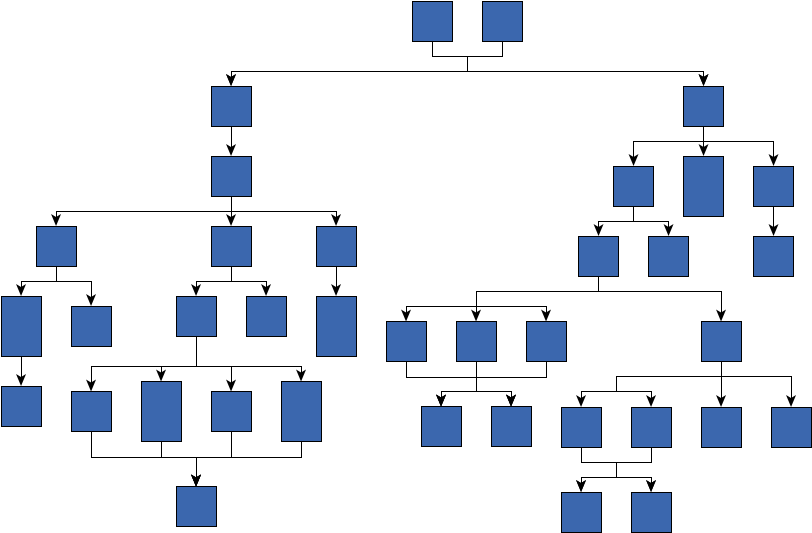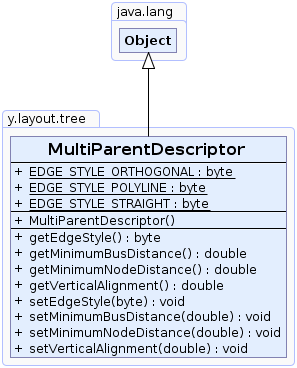 y.layout.tree.MultiParentDescriptor
y.layout.tree.MultiParentDescriptor
|
Search this API | ||||||||
| PREV CLASS NEXT CLASS | FRAMES NO FRAMES | ||||||||
| SUMMARY: NESTED | FIELD | CONSTR | METHOD | DETAIL: FIELD | CONSTR | METHOD | ||||||||
java.lang.Objecty.layout.tree.MultiParentDescriptor
public class MultiParentDescriptor
The MultiParentDescriptor provides style information for multi-parent structures.
This class is used by GenericTreeLayouter to determine the desired layout of nodes that constitute a
multi-parent structure. All nodes of such a structure are placed side by side and the incident edges are routed over
common points for incoming edges and for outgoing edges.

A tree graph containing multi-parent structures
GenericTreeLayouter.MULTI_PARENT_DESCRIPTOR_DPKEY
| Field Summary | |
|---|---|
static byte |
EDGE_STYLE_ORTHOGONAL
Routing style for routing non-shared edge segments in an orthogonal fashion. |
static byte |
EDGE_STYLE_POLYLINE
Routing style for routing non-shared edge segments in a polyline fashion. |
static byte |
EDGE_STYLE_STRAIGHT
Routing style for routing non-shared edge segments straight. |
| Constructor Summary | |
|---|---|
MultiParentDescriptor()
Creates a new MultiParentDescriptor instance with default settings. |
|
| Method Summary | |
|---|---|
byte |
getEdgeStyle()
Returns the routing style for edges that connect to nodes which constitute a multi-parent structure. |
double |
getMinimumBusDistance()
Returns the minimum distance between the nodes of a multi-parent structure and the bus connecting these nodes. |
double |
getMinimumNodeDistance()
Returns the minimum distance between two nodes belonging to the same multi-parent structure. |
double |
getVerticalAlignment()
Returns the relative vertical alignment of nodes belonging to the same multi-parent structure. |
void |
setEdgeStyle(byte style)
Specifies the routing style for edges that connect to nodes which constitute a multi-parent structure. |
void |
setMinimumBusDistance(double minimumBusDistance)
Specifies the minimum distance between the nodes of a multi-parent structure and the bus connecting these nodes. |
void |
setMinimumNodeDistance(double minimumNodeDistance)
Specifies the minimum distance between two nodes belonging to the same multi-parent structure. |
void |
setVerticalAlignment(double verticalAlignment)
Specifies the relative vertical alignment of nodes belonging to the same multi-parent structure. |
| Methods inherited from class java.lang.Object |
|---|
clone, equals, finalize, getClass, hashCode, notify, notifyAll, toString, wait, wait, wait |
| Field Detail |
|---|
public static final byte EDGE_STYLE_POLYLINE
The edges connected to a multi-parent structure will share their paths until shortly above/below the multi-parent nodes. This style only applies to the part of the edges where they split to connect to different multi-parents.
public static final byte EDGE_STYLE_ORTHOGONAL
The edges connected to a multi-parent structure will share their paths until shortly above/below the multi-parent nodes. This style only applies to the part of the edges where they split to connect to different multi-parents.
public static final byte EDGE_STYLE_STRAIGHT
The edges connected to a multi-parent structure will share their paths until shortly above/below the multi-parent nodes. This style only applies to the part of the edges where they split to connect to different multi-parents.
| Constructor Detail |
|---|
public MultiParentDescriptor()
MultiParentDescriptor instance with default settings.
| Method Detail |
|---|
public double getMinimumNodeDistance()
The distance needs to be non-negative.
setMinimumNodeDistance(double)public void setMinimumNodeDistance(double minimumNodeDistance)
The distance needs to be non-negative.
public double getMinimumBusDistance()
The minimum distance needs to be non-negative.
setMinimumBusDistance(double)public void setMinimumBusDistance(double minimumBusDistance)
The minimum distance needs to be non-negative.
public double getVerticalAlignment()
A value of 0 means that nodes are top-aligned;
a value of 1 means that nodes are bottom-aligned;
a value of 0.5 means that nodes are center-aligned.
[0,1] will result in a compact node placement with unaligned nodes,
especially when labels are considered.
setVerticalAlignment(double)public void setVerticalAlignment(double verticalAlignment)
A value of 0 means nodes are top aligned;
a value of 1 means nodes are bottom aligned;
a value of 0.5 means nodes are center aligned.
[0,1] will result in a compact node placement with unaligned nodes,
especially when labels are considered.
public byte getEdgeStyle()
setEdgeStyle(byte)public void setEdgeStyle(byte style)
EDGE_STYLE_ORTHOGONALstyle - one of the predefined routing styles
java.lang.IllegalArgumentException - if the given routing style is unknown
|
© Copyright 2000-2025, yWorks GmbH. All rights reserved. |
||||||||
| PREV CLASS NEXT CLASS | FRAMES NO FRAMES | ||||||||
| SUMMARY: NESTED | FIELD | CONSTR | METHOD | DETAIL: FIELD | CONSTR | METHOD | ||||||||